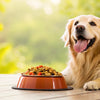What's the Best Food for Dogs to Gain Weight? A Comprehensive Guide for Pet Parents
- Houndsy
Table of Contents
- Introduction
- Understanding Underweight Dogs
- Signs Your Dog Is Underweight
- The Best Foods for Weight Gain
- Feeding Strategies to Promote Weight Gain
- The Importance of Exercise
- Conclusion
- FAQ
Introduction
Have you ever watched your dog chow down on their food, only to worry that they might be looking a little thinner than usual? You're not alone. A recent study showed that nearly 20% of dog owners are concerned about their pets being underweight. Understanding what's the best food for dogs to gain weight is crucial for ensuring our furry friends are not only healthy but also happy and energetic.
In this blog post, we will explore the various aspects of canine weight gain, including the best foods to help your dog pack on some healthy pounds, the nutritional components that contribute to weight gain, and practical tips for adjusting your dog's feeding routine. By the end of this article, we aim to equip you with the knowledge to create a tailored feeding plan that supports your dog's health and well-being. So, let’s dive into the world of dog nutrition and discover how we can help our pups thrive!
Understanding Underweight Dogs
Before we delve into specific foods, it's essential to recognize the underlying issues that might lead to your dog being underweight. Several factors can contribute to weight loss or difficulty gaining weight, including:
Health Issues
- Medical Conditions: Conditions such as diabetes, cancer, or gastrointestinal disorders can lead to weight loss. If your dog is struggling to maintain weight despite a good appetite, it’s crucial to consult with a veterinarian.
- Parasites: Intestinal parasites can rob your dog of essential nutrients, leading to weight loss. Regular deworming and preventive care can help keep your dog healthy.
- Stress or Anxiety: Changes in environment or routine can stress dogs out, impacting their appetite and weight.
Nutritional Needs
- Age and Breed: Puppies and active breeds generally require more calories than older or less active dogs. Puppies, in particular, need a calorie-dense diet to support their growth.
- Metabolism: Just like humans, dogs have varying metabolic rates. Some dogs naturally burn calories faster than others and may require additional food to maintain a healthy weight.
Signs Your Dog Is Underweight
How can you tell if your dog is underweight? Here are some telltale signs:
- Prominent Ribs and Spine: If you can easily feel your dog’s ribs and spine without applying pressure, they may be underweight.
- Loss of Muscle Mass: An underweight dog may have a noticeable loss of muscle, particularly around the back and hips.
- Tucked Abdomen: A dog with a pronounced waist and tucked abdomen may not be at an ideal weight.
If you notice these signs, it’s time to evaluate their diet and possibly consult a vet.
The Best Foods for Weight Gain
When it comes to helping your dog gain weight, the key lies in choosing the right foods. Here are some excellent options to consider:
1. High-Quality Commercial Dog Foods
Opt for dog foods specifically formulated for weight gain. Look for high-protein and high-fat options. Brands like Purina Pro Plan and Hill's Science Diet offer formulas designed for weight management and gain.
- AAFCO Compliance: Ensure the food meets the Association of American Feed Control Officials (AAFCO) standards.
- Palatability: Dogs are more likely to eat foods that are tasty and aromatic. Wet food generally has higher palatability than dry food.
2. Puppy and All-Life-Stage Foods
Puppy food is designed to support growth and development, making it richer in calories, protein, and fat. This can be beneficial for underweight adult dogs too.
- Examples: Brands like Wellness Complete Health Puppy and Merrick Grain-Free Puppy Food are excellent choices.
3. High-Calorie Treats
Incorporating high-calorie treats into your dog's diet can help in weight gain. Look for treats that are rich in protein and fat.
-
Options:
- Peanut Butter: A favorite among dogs, opt for natural peanut butter without added sugars or xylitol.
- Coconut Oil: This healthy fat can be mixed into your dog’s food for an extra calorie boost.
- Cottage Cheese: High in protein and low in lactose, this can be a great addition for dogs that tolerate dairy.
4. Homemade Additions
Adding human food can also help your dog gain weight, but it's essential to do this wisely.
- Cooked Sweet Potatoes and Pumpkin: These are not only palatable but also high in calories and fiber.
- Eggs: A great source of protein and healthy fats, scrambled or boiled eggs can be an excellent addition to your dog's diet.
5. Nutritional Supplements
Consult with your veterinarian about adding supplements to your dog's diet. Products like fish oil can provide additional calories and omega fatty acids, which are beneficial for overall health.
Feeding Strategies to Promote Weight Gain
Simply changing your dog's food may not be enough. Implementing the right feeding strategies can significantly impact your dog’s ability to gain weight.
1. Increase Meal Frequency
Instead of feeding your dog one or two large meals a day, consider offering smaller meals more frequently. This approach can enhance their appetite and help them consume more calories throughout the day.
2. Use a High-Quality Kibble Dispenser
At Houndsy, we understand that convenience plays a crucial role in feeding routines. Our Houndsy Kibble Dispenser allows you to serve perfect portions without the hassle. With a large storage capacity of 25–30 lbs and an ergonomic design, we make feeding easier and more enjoyable for both you and your dog. Explore the Houndsy Kibble Dispenser here.
3. Monitor Progress
Weigh your dog regularly to monitor their progress. Aiming for a gradual weight increase is essential. Aim for a weight gain of 1-2% per week.
4. Create a Calm Feeding Environment
Stress can negatively impact a dog’s appetite. Ensure a calm and quiet space for feeding. If you have multiple pets, consider feeding them separately to reduce competition and anxiety.
The Importance of Exercise
While it may seem counterintuitive, regular exercise can be beneficial for underweight dogs. Exercise stimulates appetite and promotes muscle gain rather than just fat accumulation.
1. Choose Appropriate Activities
Engage your dog in activities they enjoy—whether it’s a leisurely walk, a game of fetch, or even swimming.
2. Gradual Increase in Activity
If your dog has been sedentary, gradually introduce exercise to build their strength and stamina.
Conclusion
Helping your dog gain weight can be a fulfilling journey when approached with the right knowledge and resources. By choosing high-quality, calorically dense foods, implementing effective feeding strategies, and monitoring their progress, we can ensure our furry companions are not only healthy but also thriving.
As you embark on this journey, remember that consistency is key. And don’t forget to make feeding easier and more enjoyable with our Houndsy Kibble Dispenser. Order now to simplify your dog's feeding routine and help them thrive!
FAQ
What are the signs that my dog is underweight?
Signs include prominent ribs and spine, loss of muscle mass, and a tucked abdomen.
How can I help my dog gain weight safely?
Introduce high-calorie foods, increase meal frequency, and consult a veterinarian if necessary.
Is it safe to feed my dog human food to gain weight?
Yes, but focus on healthy options like sweet potatoes, eggs, and peanut butter while avoiding harmful ingredients.
How often should I feed my underweight dog?
Feeding smaller meals multiple times a day can help increase caloric intake.
When should I consult a veterinarian about my dog's weight?
If your dog is losing weight despite eating well, or if you notice any concerning symptoms, it is best to consult a vet.












